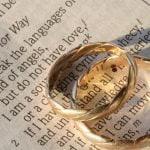The tradition of exchanging wedding rings holds deep cultural and symbolic significance in many societies around the world. It is a ritual that signifies the bond and commitment between two individuals, marking the start of their journey as a married couple. One of the key aspects of this tradition is the placement of the wedding ring on a specific hand, which varies across different cultures and traditions.
For centuries, wedding rings have been an integral part of marriage ceremonies, with their origin dating back to ancient civilizations. The significance and symbolism attached to these rings have evolved over time, with different cultures attributing their own beliefs and traditions to the act of wearing a wedding ring.
The placement of a wedding ring-whether on the left hand or right hand-holds cultural and traditional significance for many societies. This practice is deeply rooted in historical customs and beliefs, often varying widely depending on geographical location and religious influence. Understanding the significance behind the placement of a wedding ring sheds light on the rich tapestry of cultural practices that have shaped this timeless tradition.
The History of Wedding Rings
In ancient Rome, the wedding ring was more than just a symbol of love; it also served as a public pledge that the couple was officially betrothed. The use of gold wedding rings became popular during the Roman Empire, signifying wealth and status within society. This tradition later spread throughout Europe as part of the Christian wedding ceremony.
As time passed, the tradition of exchanging wedding rings continued to evolve. Different cultures developed their own customs and beliefs regarding the significance and placement of wedding rings. Today, these rituals have become an integral part of wedding ceremonies around the world, with each culture adding its unique twist to this age-old practice.
From ancient Egypt to modern-day weddings, the symbolism behind the exchange of wedding rings continues to hold great significance for couples embarking on their journey together. The rich history behind this tradition demonstrates how something as simple as wearing a ring on a specific hand can carry deep cultural and historical meaning. Understanding this history can add an extra layer of depth and importance to the act of exchanging wedding rings.
| Wedding Ring Tradition | Historical Significance |
|---|---|
| Ancient Egypt | Braided reed and hemp rings symbolizing eternity |
| Roman Empire | Gold rings signifying wealth and status |
| Modern-day Weddings | Cultural customs and beliefs influencing ring placement |
What Hand Is a Wedding Ring Worn On
When it comes to wearing a wedding ring, there are various cultural practices and beliefs regarding which hand the ring should be placed on. Different countries and cultures have their own traditions and customs when it comes to this important piece of jewelry. Understanding these cultural practices can provide insight into the significance of wedding rings in different societies.
In some cultures, the wedding ring is worn on the left hand, while in others it is worn on the right hand. Additionally, there are certain countries where individuals wear their wedding rings on different hands depending on whether they are married or engaged. For example:
- In many Western cultures, including the United States and most European countries, the wedding ring is traditionally worn on the left hand.
- In Eastern European countries like Russia, Bulgaria, and Poland, as well as in India and Greece, the wedding ring is typically worn on the right hand.
- In some South American countries like Brazil and Argentina, as well as in certain Scandinavian countries like Denmark and Norway, individuals wear their wedding rings on their right hand when they are engaged and then switch to their left hand once they are married.
The significance of wearing a wedding ring on a specific hand varies from culture to culture. In some cases, it may symbolize a person’s commitment or marital status. Understanding these cultural practices can help individuals appreciate the diversity of traditions surrounding such a universal symbol of love and commitment.
Overall, understanding what hand a wedding ring is traditionally worn on provides valuable insight into diverse cultural practices and beliefs surrounding marriage and commitment. By exploring these traditions, one can gain a deeper appreciation for the symbolism behind wearing a wedding ring on a specific hand.
The Left Hand vs the Right Hand
The placement of wedding rings on the left or right hand varies significantly across different countries and cultures. This cultural diversity reflects the rich history and traditions associated with the significance of marriage and commitment. Let’s take a closer look at some of the differences in traditions regarding what hand is a wedding ring worn on:
In many Western cultures, including the United States and most European countries, the traditional placement for a wedding ring is on the left hand. This practice can be traced back to ancient Roman beliefs that a vein in the left ring finger, known as the “vena amoris” or “vein of love,” was directly connected to the heart. Therefore, wearing a wedding ring on the left hand symbolizes the connection to one’s heart and emotional bond with their partner.
Conversely, in Eastern European and some South American countries, it is customary to wear wedding rings on the right hand. For example, in Russia, couples typically exchange rings during their engagement ceremony and then move them to their right hands once married. This tradition is believed to symbolize strength and fidelity within marriage, as well as differentiate between engagement and marriage.
In some Asian cultures, such as India and Japan, there may not be a specific custom regarding which hand a wedding ring should be worn on. Instead, couples may choose based on personal preference or religious beliefs. For example, Hindu traditions may dictate wearing rings on specific fingers for auspicious reasons.
To summarize:
- In many Western cultures: Left Hand
- In Eastern European and some South American countries: Right Hand
- In some Asian cultures: Personal preference or religious beliefs
Understanding these cultural differences can help couples respect each other’s backgrounds while making decisions about how they want to honor their commitment through their wedding rings.
The Role of Religion
This practice is based on the ancient belief that a vein in this finger leads directly to the heart, symbolizing love and commitment. As a result, many Christian couples choose to adhere to this tradition when exchanging rings during their wedding ceremony.
Similarly, in Islamic cultures, it is customary for men to wear their wedding ring on their right hand, while women typically wear theirs on their left hand. This distinction is rooted in religious teachings and societal norms specific to each region within the Islamic world. In some Hindu traditions, the placement of the wedding ring may also vary based on specific customs and religious beliefs.
Moreover, certain religious ceremonies and rituals related to marriage may involve blessings or prayers specifically dedicated to the wedding rings. These blessings are often performed by clergy members or spiritual leaders as part of the matrimonial celebration. The significance placed on these religious customs underscores the profound influence of faith and spirituality on how wedding rings are worn and regarded within different cultural contexts.
| Religion | Placement of Wedding Ring |
|---|---|
| Christianity | Traditionally worn on the fourth finger of the left hand |
| Islam | Men typically wear it on their right hand, women on their left hand |
| Hinduism | Varying customs and traditions regarding placement |
Overall, it is evident that religious beliefs have a profound impact on how wedding rings are worn and perceived within diverse cultural settings. Understanding these influences can provide invaluable insight into why certain traditions endure through generations and continue to hold deep significance for couples as they exchange vows and pledge their love for one another.
Modern Trends
In today’s modern society, many couples are redefining traditional customs and practices, including the placement of wedding rings. With changing cultural norms and personal preferences, the once strict adherence to placing the wedding ring on a specific hand has become more flexible and open to individual interpretation.
Personalization and Creativity
Unconventional couples are increasingly opting for unique and creative ways to wear their wedding rings. Some choose to wear their rings on non-traditional fingers, such as the middle finger or even the thumb, as a symbol of personal expression and individuality. Others may opt for multiple rings on different fingers or hands, reflecting their own unique love story and bond.
Equality in Marriage
In contemporary times, there is a growing emphasis on equality within marriage. As a result, some couples choose to wear matching rings on the same hand or finger in order to symbolize their equal partnership. This departure from traditional placement reflects a shift towards shared responsibilities and mutual respect in modern relationships.
Non-Conventional Materials
With modern advancements in jewelry-making, some couples are opting for unconventional materials for their wedding rings such as titanium, wood, or even silicone. In line with this trend, they may also choose to wear these unique bands on different hands or fingers as a way of expressing their individuality and breaking away from traditional norms.
As societal norms continue to evolve, so do the customs surrounding weddings and marriage. Modern trends in the placement of wedding rings reflect a shift towards personalization, equality, and creativity within relationships. Ultimately, these changes signify a departure from stringent traditions towards more individualized expressions of love and commitment.
Personal Preferences
Many individuals have personal reasons for choosing to wear their wedding ring on a specific hand. For some, it may be a matter of preference based on their dominant hand. Others may have sentimental or cultural reasons for selecting a particular hand for their wedding ring.
Some people choose to wear their wedding ring on their left hand because it is closer to the heart according to traditional beliefs and symbolism. The left hand is often associated with love, commitment, and fidelity, making it a fitting choice for the placement of a wedding ring. In contrast, others may opt to wear their wedding ring on the right hand as a symbol of individuality and personal choice, especially in cultures where this is the norm.
Additionally, some individuals may have practical reasons for choosing which hand to place their wedding ring on. For example, those who work in professions that require frequent use of their hands may prefer to wear their ring on the less dominant hand to protect it from potential damage or loss.
Others may simply find that one hand feels more comfortable or natural for wearing jewelry. Ultimately, personal preferences play a significant role in determining which hand a wedding ring is worn on.
It’s important to recognize that each person’s decision regarding which hand to wear their wedding ring on is deeply personal and can hold significant meaning for them. Whether influenced by tradition, belief, practicality, or sentimentality, these individual choices contribute to the rich tapestry of cultural practices surrounding wedding rings.
Conclusion
In conclusion, the placement of a wedding ring holds significant cultural and personal meaning that varies across different traditions and beliefs. While there is no universal rule for what hand a wedding ring should be worn on, the various practices and customs reflect the rich history and diversity of cultural traditions around the world.
Understanding the significance behind the placement of a wedding ring is important as it represents a commitment and bond between two individuals. The history of wedding rings dates back centuries, and the different customs associated with their placement offer insight into the values and beliefs of different societies.
As modern trends continue to evolve, many couples are redefining traditional practices and choosing to wear their wedding rings according to their personal preferences rather than adhering strictly to cultural or religious norms. Ultimately, whether it’s worn on the left hand, right hand, or even on a necklace, what matters most is the love and commitment symbolized by the exchange of rings during this special occasion.
Frequently Asked Questions
What Does It Mean to Wear Wedding Ring on Right Hand?
Wearing a wedding ring on the right hand can have different meanings depending on culture and tradition. In some countries, it may symbolize a connection to the spouse’s family, while in others it may indicate a separation from the single life.
What Finger Is the Engagement Ring?
The engagement ring is typically worn on the fourth finger of the left hand, also known as the ring finger. This tradition dates back to ancient times when it was believed that this finger contained a vein that led directly to the heart.
Why Does a Wedding Ring Go on the Left Hand?
The tradition of wearing a wedding ring on the left hand can be traced back to ancient Egypt, where it was believed that the “vena amoris” or “vein of love” ran from the fourth finger of the left hand straight to the heart.
This belief has since been passed down through generations and is now a common practice in many cultures around the world.

Welcome to my blog about home and family. This blog is a place where I will share my thoughts, ideas, and experiences related to these important topics. I am a stay-at-home mom with two young children. I hope you enjoy reading it! and may find some helpful tips and ideas that will make your home and family life even better!





